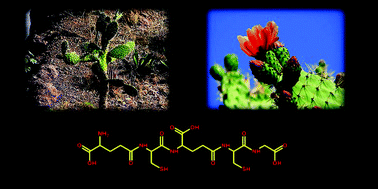Analysis of phytochelatins in nopal (Opuntia ficus): a metallomics approach in the soil–plant system
Abstract
This work focuses on phytochelatins (PCs) in plants chronically exposed to low or moderate metal concentrations in soil, which commonly occurs in natural environments. The original approach was to evaluate PCs in nopal (Opuntia ficus) in relation to the plant and soil levels of Cd, Pb, Cu and Ag. These four metals were selected because of their known capability to induce PCs in plants and also because of their abundance in the region of Guanajuato (Mexico), where the nopal plants were collected. ICP-MS determination of metals in nopal roots, stems and in soil fractions provided information relevant to their bioavailability in soil as well as their uptake by nopal. In search of a possible relationship between the parameters measured, correlation analysis was carried out (Cd was not considered owing to its low levels found in the plant tissues). The results obtained indicate that sequential metal leaching from soil does not always provide direct information on metal bioavailability. The uptake of metals by nopal roots correlated with metals in the organic matter and sulfides fraction. Since low levels of humic substances were found in soil collected at cactus roots and because of the low solubility of Pb, Cu and Ag sulfides, the participation of rizosphere processes was suggested in facilitating metal uptake. Metal distribution in PC molecular mass fractions were studied by SEC-ICP-MS and the results compared with the total phytochelatin pool in plants as determined by reversed phase HPLC with spectrofluorimetric detection. The two procedures provide complementary analytical information when the global effect of all metals/metalloids present in soil on PC production is to be studied. Correlation analysis revealed the strong association of Pb with PCs both in roots and in stems, which demonstrates that Pb is important in nopal PCs and suggests that Pb bound to PCs might be transported from roots to stems. For Cu, the correlation between metal-free PCs and metal bound to high molecular mass fraction of plant PC-rich extract was observed only in roots, suggesting differences in the transport of Pb and Cu. In contrast to these metals, no correlation was found for silver, suggesting no association with PCs, even though its elution with a high molecular mass fraction was observed in PC-rich plant extracts. The results obtained from this study indicate the complex role environmental conditions play in the accumulation of heavy metals and in phytochelatin production in the Opuntia genus.

- This article is part of the themed collection: Metallomics

 Please wait while we load your content...
Please wait while we load your content...